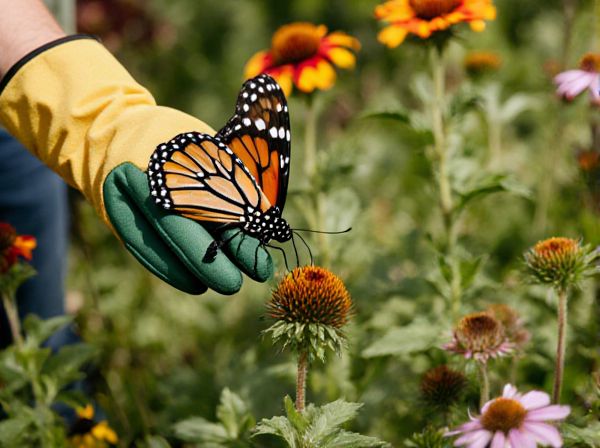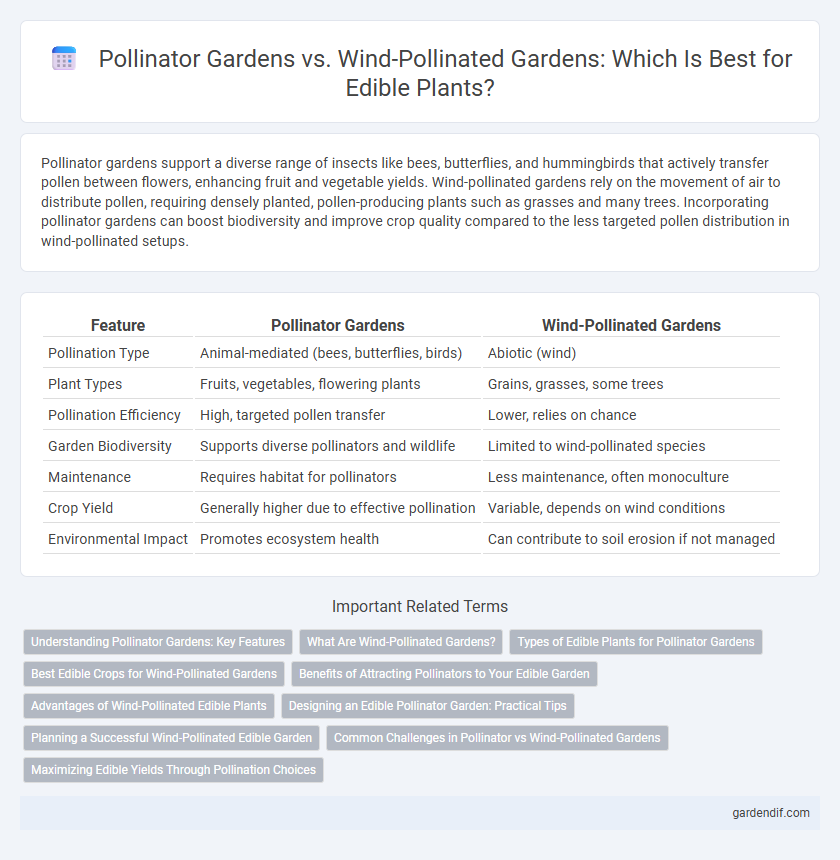
Pollinator Gardens vs Wind-Pollinated Gardens Illustration
Pollinator gardens support a diverse range of insects like bees, butterflies, and hummingbirds that actively transfer pollen between flowers, enhancing fruit and vegetable yields. Wind-pollinated gardens rely on the movement of air to distribute pollen, requiring densely planted, pollen-producing plants such as grasses and many trees. Incorporating pollinator gardens can boost biodiversity and improve crop quality compared to the less targeted pollen distribution in wind-pollinated setups.
Table of Comparison
| Feature | Pollinator Gardens | Wind-Pollinated Gardens |
|---|---|---|
| Pollination Type | Animal-mediated (bees, butterflies, birds) | Abiotic (wind) |
| Plant Types | Fruits, vegetables, flowering plants | Grains, grasses, some trees |
| Pollination Efficiency | High, targeted pollen transfer | Lower, relies on chance |
| Garden Biodiversity | Supports diverse pollinators and wildlife | Limited to wind-pollinated species |
| Maintenance | Requires habitat for pollinators | Less maintenance, often monoculture |
| Crop Yield | Generally higher due to effective pollination | Variable, depends on wind conditions |
| Environmental Impact | Promotes ecosystem health | Can contribute to soil erosion if not managed |
Understanding Pollinator Gardens: Key Features
Pollinator gardens contain diverse flowering plants that produce nectar and pollen essential for bees, butterflies, and other pollinators, promoting biodiversity and ecosystem health. These gardens feature native plant species, continuous bloom periods, and habitat structures like nesting sites, ensuring a stable food supply and shelter for pollinators. Unlike wind-pollinated gardens that rely on air currents for pollen dispersal, pollinator gardens foster direct interactions between plants and pollinators, enhancing fruit and seed production.
What Are Wind-Pollinated Gardens?
Wind-pollinated gardens consist primarily of plants that rely on the breeze to transfer pollen from male to female flowers, such as grasses, corn, and many trees like oaks and pines. These gardens typically feature flowers with small, inconspicuous petals and high pollen production to increase the chances of successful pollination. Unlike pollinator gardens designed to attract bees and butterflies, wind-pollinated setups require open spaces to facilitate effective pollen dispersal.
Types of Edible Plants for Pollinator Gardens
Pollinator gardens feature edible plants like berries, tomatoes, cucumbers, and herbs that rely on insect pollination by bees, butterflies, and other pollinators for fruit and seed production. These gardens often include flowers such as lavender and sunflowers that attract pollinators while providing edible yields. In contrast, wind-pollinated gardens cultivate grains like corn, wheat, and rye that do not depend on animal pollinators but rely on airborne pollen for fertilization.
Best Edible Crops for Wind-Pollinated Gardens
Wind-pollinated gardens thrive with edible crops such as corn, wheat, and rye, which rely on air currents rather than insect pollinators. These cereals, along with some nut trees like pecans and walnuts, produce abundant yields without requiring vibrant flowers or insect attraction. Selecting wind-pollinated crops reduces dependence on pollinator populations while optimizing space for staple grain production.
Benefits of Attracting Pollinators to Your Edible Garden
Attracting pollinators to your edible garden enhances fruit and vegetable yields by improving pollination efficiency and diversity, which supports better crop quality and quantity. Pollinator gardens provide essential habitats for bees, butterflies, and other beneficial insects, increasing biodiversity and promoting ecosystem health within your garden. These gardens reduce the need for artificial pollination methods and pesticides, leading to more sustainable and environmentally friendly food production.
Advantages of Wind-Pollinated Edible Plants
Wind-pollinated edible plants require less maintenance and attract fewer pests compared to pollinator gardens, reducing the need for pesticides and increasing crop health. These plants, such as corn, wheat, and barley, can produce higher yields due to efficient pollen distribution over long distances by wind. Wind pollination is also less dependent on pollinator populations, ensuring more stable food production even in environments with declining bee or insect numbers.
Designing an Edible Pollinator Garden: Practical Tips
Designing an edible pollinator garden involves selecting a diverse mix of flowering plants like herbs, fruits, and vegetables that attract bees, butterflies, and other beneficial insects. Incorporate native wildflowers and avoid pesticides to enhance pollination efficiency and promote ecosystem health. Use staggered bloom times and provide water sources to ensure continuous support for pollinators throughout the growing season.
Planning a Successful Wind-Pollinated Edible Garden
Planning a successful wind-pollinated edible garden requires selecting crops like corn, rye, or spinach, which rely on air movement for pollination rather than insects. Strategic spacing and orientation of plants maximize pollen distribution by wind, enhancing fertilization rates and yield. Incorporating buffer zones minimizes cross-pollination from unwanted varieties, ensuring crop purity and productivity.
Common Challenges in Pollinator vs Wind-Pollinated Gardens
Pollinator gardens often face challenges such as attracting and sustaining diverse pollinator populations amid habitat loss and pesticide exposure, which can limit effective pollination. Wind-pollinated gardens struggle with inefficient pollen dispersal due to unpredictable weather conditions and spatial constraints that reduce wind flow. Both garden types require strategic plant selection and environmental management to maximize reproductive success and crop yield.
Maximizing Edible Yields Through Pollination Choices
Pollinator gardens attract bees, butterflies, and other insects that enhance fruit and vegetable yields by facilitating targeted pollination of crops like tomatoes, cucumbers, and berries. Wind-pollinated gardens rely on natural air currents to disperse pollen, which is effective for grains such as corn, wheat, and rye but typically produces lower edible yields for fruiting plants. Maximizing edible yields involves selecting pollination strategies aligned with specific crop types, emphasizing insect-mediated pollination for high-value fruits and vegetables to increase productivity.
Pollinator Gardens vs Wind-Pollinated Gardens Infographic

 gardendif.com
gardendif.com